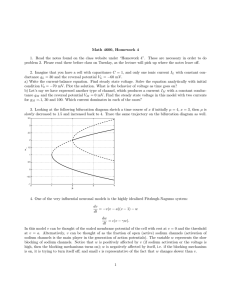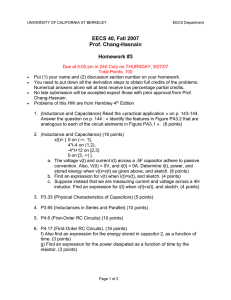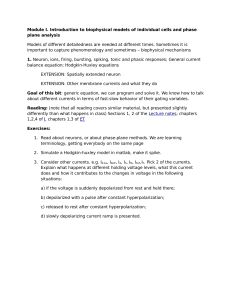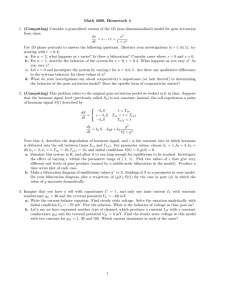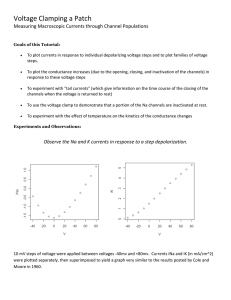Math 4600, Homework 4
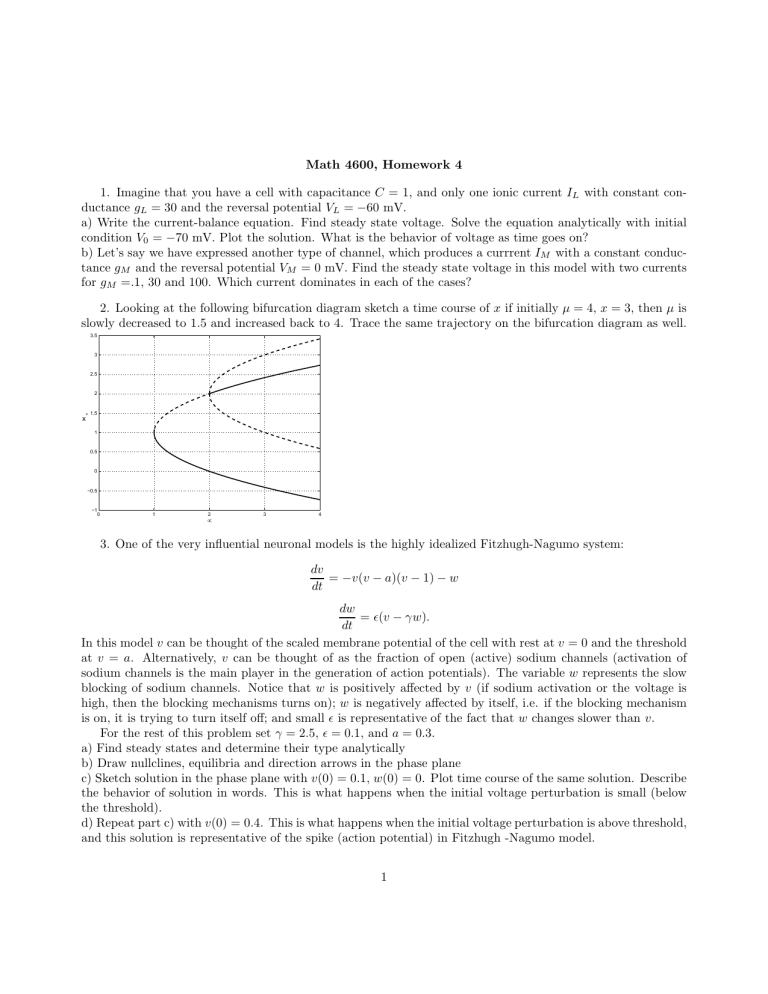
x
*
1.5
1
0.5
2.5
2
Math 4600, Homework 4
1. Imagine that you have a cell with capacitance C = 1, and only one ionic current I
L with constant conductance g
L
= 30 and the reversal potential V
L
=
−
60 mV.
a) Write the current-balance equation. Find steady state voltage. Solve the equation analytically with initial condition V
0
=
−
70 mV. Plot the solution. What is the behavior of voltage as time goes on?
b) Let’s say we have expressed another type of channel, which produces a currrent I
M with a constant conductance g
M and the reversal potential V
M
= 0 mV. Find the steady state voltage in this model with two currents for g
M
=.1, 30 and 100. Which current dominates in each of the cases?
2. Looking at the following bifurcation diagram sketch a time course of x if initially µ = 4, x = 3, then µ is slowly decreased to 1.5 and increased back to 4. Trace the same trajectory on the bifurcation diagram as well.
3.5
3
0
−0.5
−1
0 1 2
µ
3 4
3. One of the very influential neuronal models is the highly idealized Fitzhugh-Nagumo system: dv dt
=
− v ( v
− a )( v
−
1)
− w dw dt
= ǫ ( v
−
γw ) .
In this model v can be thought of the scaled membrane potential of the cell with rest at v = 0 and the threshold at v = a . Alternatively, v can be thought of as the fraction of open (active) sodium channels (activation of sodium channels is the main player in the generation of action potentials). The variable w represents the slow blocking of sodium channels. Notice that w is positively affected by v (if sodium activation or the voltage is high, then the blocking mechanisms turns on); w is negatively affected by itself, i.e. if the blocking mechanism is on, it is trying to turn itself off; and small ǫ is representative of the fact that w changes slower than v .
For the rest of this problem set γ = 2 .
5, ǫ = 0 .
1, and a = 0 .
3.
a) Find steady states and determine their type analytically b) Draw nullclines, equilibria and direction arrows in the phase plane c) Sketch solution in the phase plane with v (0) = 0 .
1, w (0) = 0. Plot time course of the same solution. Describe the behavior of solution in words. This is what happens when the initial voltage perturbation is small (below the threshold).
d) Repeat part c) with v (0) = 0 .
4. This is what happens when the initial voltage perturbation is above threshold, and this solution is representative of the spike (action potential) in Fitzhugh -Nagumo model.
1
4.
(computing) Suppose you have a cell with two voltage-gated currents: I
T and I
K
:
I
T
= ¯
T mh ( V
−
V
T
)
I
K g
K
( V
−
V
K
) where V
T
= 0 mV, V
K
=
−
70 mV, m is fast, h is slower, ¯
T g
K have similar values, m
∞
( V ) =
1
1 + e ( V half,m −
V ) /β m
, h
∞
( V ) =
1
1 + e
−
( V half,h −
V ) /β h
,
V half,m
=
−
70, β m
= 1, V half,h
=
−
80, β h
= 1.
a) Plot activation and incativation curves of I
T
. What happens when you vary V half,m
?
β m
?
b) Suppose the voltage is kept at resting potential of this cell?
−
70mV. What would be the approximate values of the currents? What is the
(extra credit) c) What will happen if V is brought from rest down to
−
80mV, held there for a while, and then released? Sketch the time courses of m , h , I
T
, I
K and V . This effect is called post-inhibitory rebound when a cell can be activated (depolarized) by am inhibitory (negative) signal.
2

